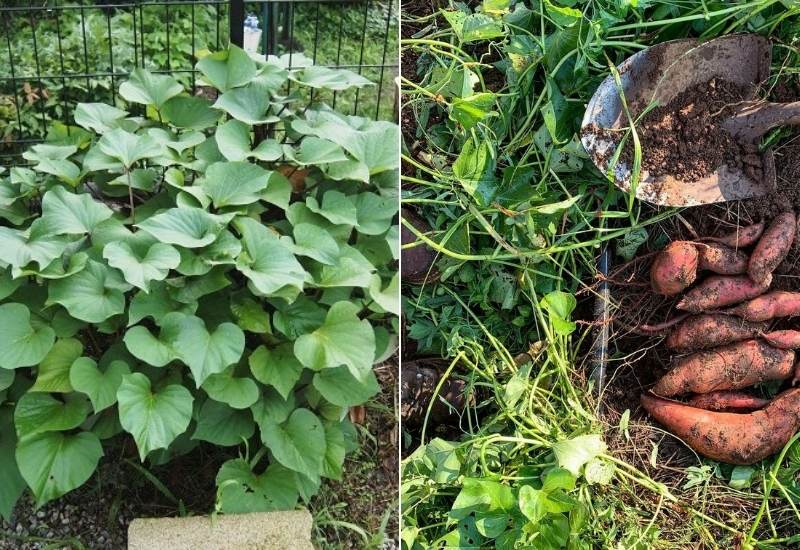
Growing sweet potatoes in containers is surprisingly more straightforward than you might imagine.
When it grows in its native environment, sweet potatoes are perennials, but they grow as annual plants in containers.
It’s hard not to love sweet potatoes, and growing them in your backyard garden is an excellent option if you love them.
Like regular potatoes, sweet potatoes are tubers that form and grow underground. So, growing them in containers makes perfect sense!
One of the most significant differences between growing regular potatoes and sweet potatoes is that the latter requires a much longer growing season to reach maturity. It can take up to 150 days to reach full maturity to harvest, and it also needs a warmer soil than other types of potatoes.
Growing sweet potatoes is a little different than growing regular potatoes, but if you’ve grown them, it will make the process a bit easier to understand.
Some of the most significant differences are the harvesting as well as an easier harvesting experience.
If you’re ready to give growing sweet potatoes in containers a try, this guide will show you how to grow a massive potato harvest from pots.
From the right soil to planting the slips, we’ll show you everything that you need to know.
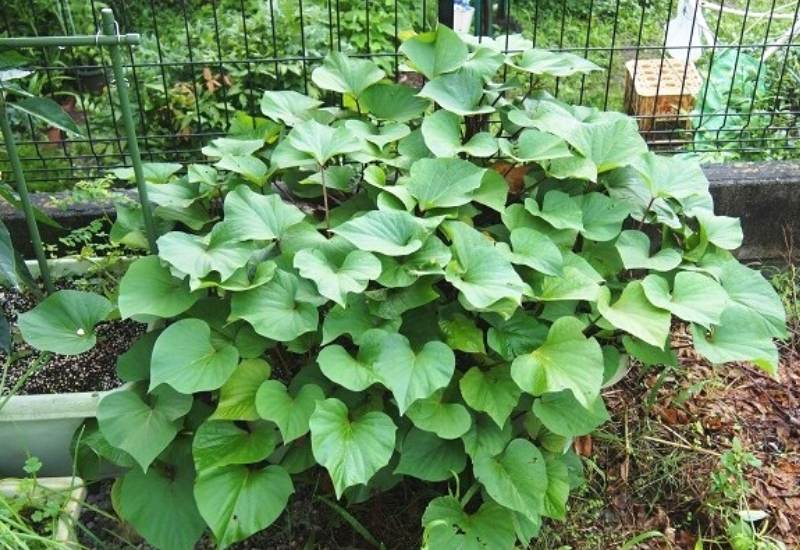
How to Start Growing Sweet Potatoes in Containers
Are you ready to learn how to grow sweet potatoes in containers? Let’s take a look at the steps needed.
1. Know When To Plant Sweet Potatoes
No matter whether or not you’re growing sweet potatoes in containers, they still prefer to be planted when the days and nights are warm. These are not cool-weather crops, and they don’t tolerate a frosting well.
So, you need to find out your USDA hardiness zone and use that to find your final frost date. Remember, these are averages, and it’s typically best to wait a week or two after this date in case of a rogue frost that could wipe out your garden.
Those things happen!
Sweet potatoes cannot be planted or put outside until the soil has reached 60℉, and the nighttime temperatures need to be above 60℉ consistently.
2. Get Sweet Potato Slips
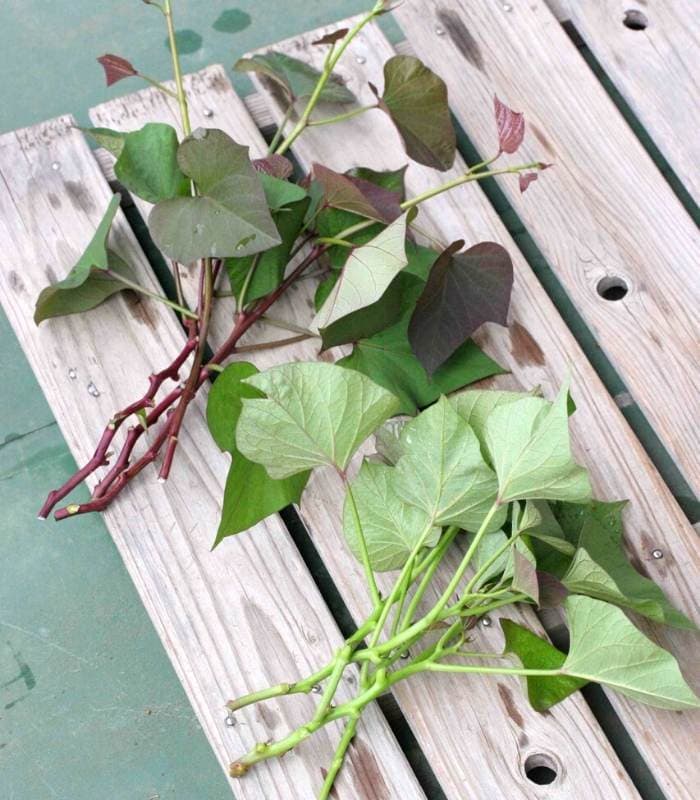
While you could start sweet potatoes from seeds, most gardeners plant slips, which should be available at most garden centers or plant nurseries.
Avoid using sweet potatoes at the grocery store because you cannot be sure what variety they are, or here they grew. Some variations in the store could harbor diseases as well.
Each of the slips should be unblemished and measure 1 ½ inch in diameter. They should each have a sprout on them.
What would a sprout look like?
If you leave your potatoes in the pantry for too long, they start to develop sprouts. Typically, you can cut off the sprouts and cook dinner, but those sprouts can also be used to grow your sweet potatoes.
3. Find A Suitable Container
The next thing you need to do is pick a suitable container. Ideally, you should avoid plastic or metal containers. Clay containers or whiskey barrels are two excellent choices.
Another choice would be a container specifically created for potatoes is an excellent choice, and they tend to be inexpensive. You can find potato grow bags that come in a range of colors. These bags are designed to aerate the roots, proper adequate drainage, and side pockets for pulling out small spuds if you want.
If you want to use a grow bag, harvesting is as easy as dumping out the contents and sorting through the soil.
No matter what you pick, make sure the container has drainage holes.
4. Pick The Best Location For Your Container
Location is a massive deal for growing sweet potatoes because they’re quite picky about where you grow them. They want to be in a sunny place at all times of the day and night.
So, pick a location that has full sunlight throughout the day, which means the plants need 6-8 hours of sunshine per day.
5. Prepare The Soil
Now that you have a container selected, you need to prepare the soil for your sweet potatoes. Sweet potatoes like well-draining, sandy soil, and it’s best to add compost to the ground. Compost adds nutrients to your soil while also increasing the drainage of the dirt.
6. Warm The Soil
Remember, the soil has to be at least 60℉. Before planting, you should cover the ground with a black plastic cover for several weeks. Doing this helps to increase the temperature of the soil and will help your plants grow better.
7. Plant The Sweet Potatoes In The Containers
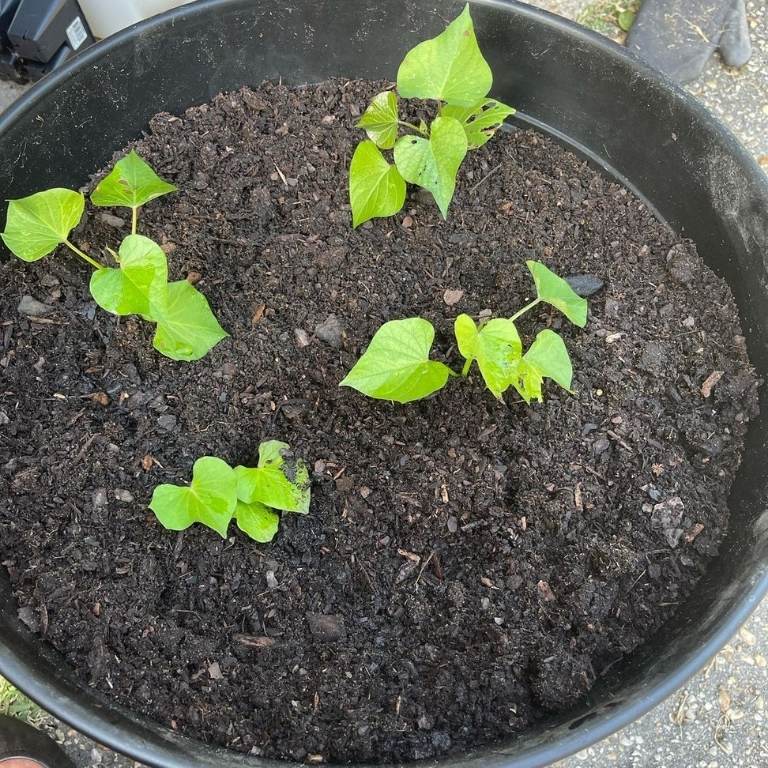
Once you have the soil ready for planting, it’s time to plant the sweet potatoes in the container. Put around four inches of soil into the containers. Then, it’s time to put the slips on top of the dirt you just added.
Each transplant that you use should be placed 12 inches apart. Make sure the sprout is placed upwards towards the sky, and then cover the slips with soil. Be sure to add three to four inches of soil on top of the potato slips.
You should keep the potted sweet potatoes indoors for the first 12 weeks before moving them outside if you live in a location that doesn’t have 150 frost-free days. Put the pots outside four weeks after the final frost date.
After you move the plants outside, you do need to protect them from cool evenings. It’s quite easy for temperatures to dip down below the 60℉ without you realizing it.
The best thing to do is to keep your pots covered with garden fabric for three to four weeks afterward.
Not only does keeping your containers covered speed up early growth, but it also reduces the stress that is placed on your plants due to temperature fluctuations.
How to Take Care of Sweet Potatoes in Containers
Now that your sweet potatoes are growing happily in your containers, you have to know how to take care of those plants.
1. Water Regularly

You should water your potted sweet potatoes at least once a week or as needed, based on rainfall. You mustn’t overwater your plants; they don’t like standing water.
2. Use Fertilizer Weeks After Planting
You’ll want to add fertilizer to the container several weeks after planting. Some gardeners have success with an organic fish emulsion.
Another choice is to use a 5-10-10 fertilizer in your containers. It should have plenty of trace minerals as well as NPK<, but be sure the nitrogen amount isn’t too high!
3. Mulch Around Your Plants

Another important task that you need to do to keep your plants happy is to mulch around the plants.
You can use black plastic or any type of mulch that you want. The goal of the mulch is to keep the soil as warm as possible. Remember, sweet potatoes need warm soil.
Mulching also stops the vines from setting down more roots as they grow. That could take away some of the energy needed for tuber formation.
Sweet Potato Pests & Diseases
Sweet potatoes are known for several different pests and diseases. Here are a few that you might encounter.
Alternaria Leaf Spot
This fungus creates brown lesions on the leaves of the sweet potato plant that looks similar to a target. A yellow halo might surround the lesions, and over time, defoliation might occur.
You cannot treat this fungus once it takes place. When you harvest, make sure that you destroy all of the residues. The following year, try planting varieties that resist this fungus.
Fusarium Root And Stem Rot
Here is another frustrating fungus that you might encounter. It leads to the swollen and distorted base of stems, and the rot extends into the cavities of the plant.
You might also find a white mold on the plant. Infected transplants typically spread it.
Typically, these diseases aren’t a massive issue if you follow the proper health sanitation methods.
Be sure to practice crop rotation and try treating the seed roots with an appropriate fungicide before planting.
Bacterial Wilt
If your new sprouts are wilting and have bases that are turning yellow to brown, you know that there is a problem.
Bacterial wilt infects the vascular system of the sprouts, infecting once a healthy transplant. In severe cases, there might be lesions on the rot surface.
Rotating sweet potato crops is a smart idea; never use the same container year after year or scrub it out with a diluted bleach solution. Also, try growing the plant in colder periods of the year to help avoid the disease.
Sweet Potato Stem Borer
When you’re dealing with sweet potato stem borer, the larvae bury into the stems, leading to problems.
The pests start to feed at the crown region, which leads to wilting, yellowing, and the dying of the plant. You can often identify this pest by the presence of fecal matter on the soil surface.
Try to keep the area around the plant weed-free. Switch containers and change the soil out of the containers each year; the larvae can overwinter inside of the soil.
White Grub
Chances are you’re familiar with white grub and might have played with them as kids; you might know them by the name rolly pollies.
Grubs like to feed on the underground parts of plants, which includes the stems, roots, and tubes of the sweet potato plants.
Grub activity can lead to wilting and dying of plants. It’s essential to take care of the problem as fast as you can.
Make sure you don’t allow any standing water in your containers, which will encourage the development of white grub. You also can try to spray the plants with Bacillus popilliae.
Harvesting Sweet Potatoes
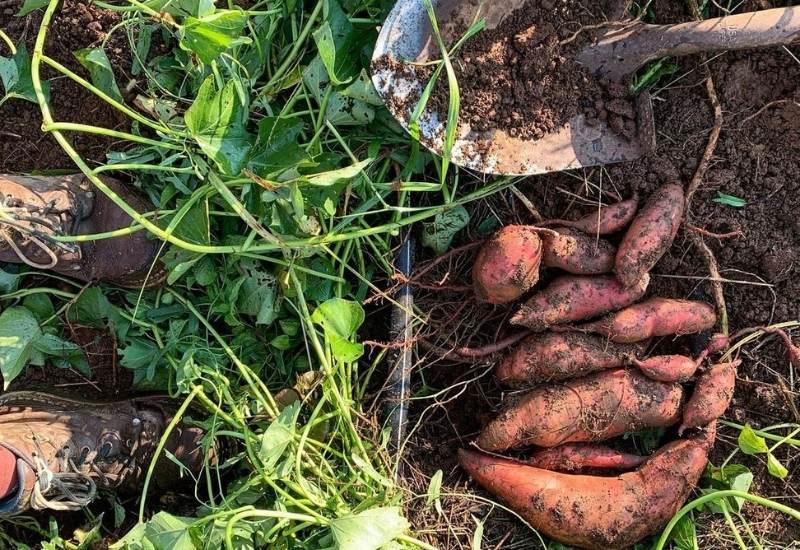
It can take up to 150 days after you start your sweet potatoes for them to reach maturity. So, whether you reach the maturity length or the first frost, harvesting sweet potatoes is a fun task for families!
Something to know is that the foliage of regular potato plants will die back when it’s time to harvest.
Sweet potatoes are not that way; they’ll continue to grow until the temperatures are too chilly. You do need to let them grow as long as possible.
Make sure you know the maturity length for the sweet potato variety that you grow.
All sweet potatoes need to be harvested before the first heavy frost. Cold temperatures can damage the sensitive tubers in the ground.
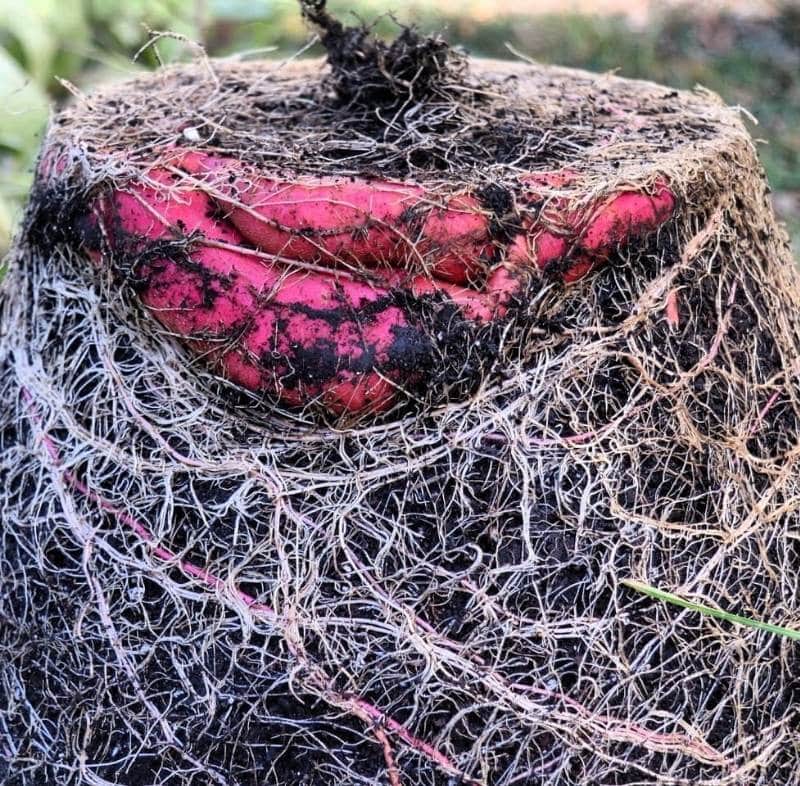
All you need is a garden fork or to dump out the containers. It’s like a fun treasure hunt, searching through the dirt to find the hidden sweet potatoes.
It’s a fun thing for kids to do in the garden, and these are easier to dig up than regular potatoes because the tubers tend to be more clustered together right at the stem.
Be sure that you treat the tubers gently when you remove them from the ground. The skin on sweet potatoes is thin, and the flesh will bruise or nick easily.
Curing Sweet Potatoes
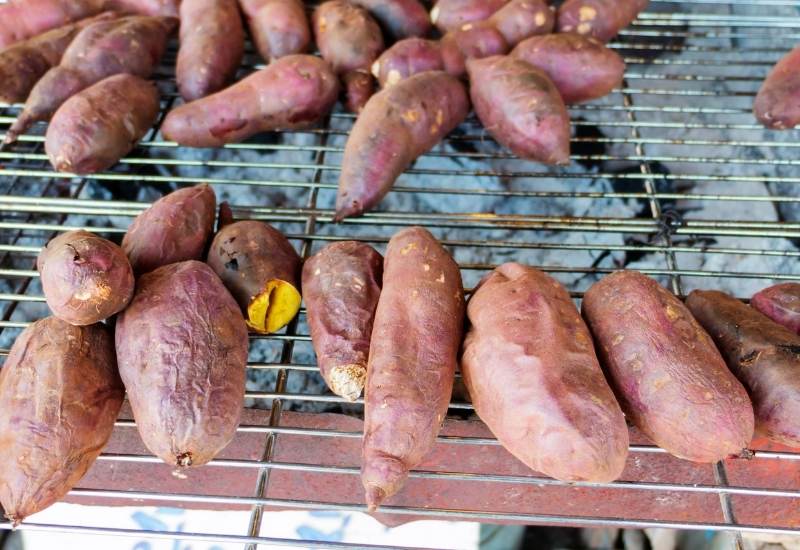
You do need to allow the potatoes to cure before eating. It’s a simple process that dries and cures the potatoes for long term storage.
Find an area with a temperature between 80-85℉, such as near a furnace or a southern-facing window in your home. The area that you use for curing needs to have high relative humidity as well.
If you need to increase the humidity, you can put the sweet potatoes in boxes or crates, then cover them with a paper towel or cloth. Another option is to store them in perforated plastic bags.
Storing Sweet Potatoes
After you harvest and cure the sweet potatoes, you need to store them in a cool, dry place with a temperature between 55-60℉ consistently.
Another option is to freeze the sweet potatoes, but you do need to blanch them before storing them to help soften them up before unthawing and cooking.
You can safely can sweet potatoes, so long as you don’t puree them. Sweet potatoes are safe for canning if you cube them without skins and use a pressure canner. You cannot safely can sweet potatoes without a pressure canner.
The Best Varieties of Sweet Potatoes for Containers
For years, those who lived in northern climates were unable to grow sweet potatoes because the growing season for these areas was too short. The sweet potatoes were unable to reach maturity before the first frost.
Nowadays, there are shorter-season sweet potato varieties, as well as ways to warm up your soil, which makes it possible for anyone to grow this crop if you love them.
Here are some varieties of sweet potatoes that grow well in pots.
Portio Rico

This is one of the most popular picks for people growing this crop in pots. It’s often referred to as bush or vineless, and it’s ideal for smaller gardens or container gardening. This cultivar has short and compact vines, two qualities perfect for growing in pots.
Vardaman

Here is another excellent pick. This variety is named after a town in Mississippi, and it’s known for its bushy habits and reined-in vines.
Final Thoughts
If you thought you couldn’t grow this crop without a lot of room, you now know that you’re wrong! Growing sweet potatoes in containers are possible, and it’s easy to get back a considerable harvest year after year.

Written By
Amber Noyes
Amber Noyes was born and raised in a suburban California town, San Mateo. She holds a master’s degree in horticulture from the University of California as well as a BS in Biology from the University of San Francisco. With experience working on an organic farm, water conservation research, farmers’ markets, and plant nursery, she understands what makes plants thrive and how we can better understand the connection between microclimate and plant health. When she’s not on the land, Amber loves informing people of new ideas/things related to gardening, especially organic gardening, houseplants, and growing plants in a small space.
